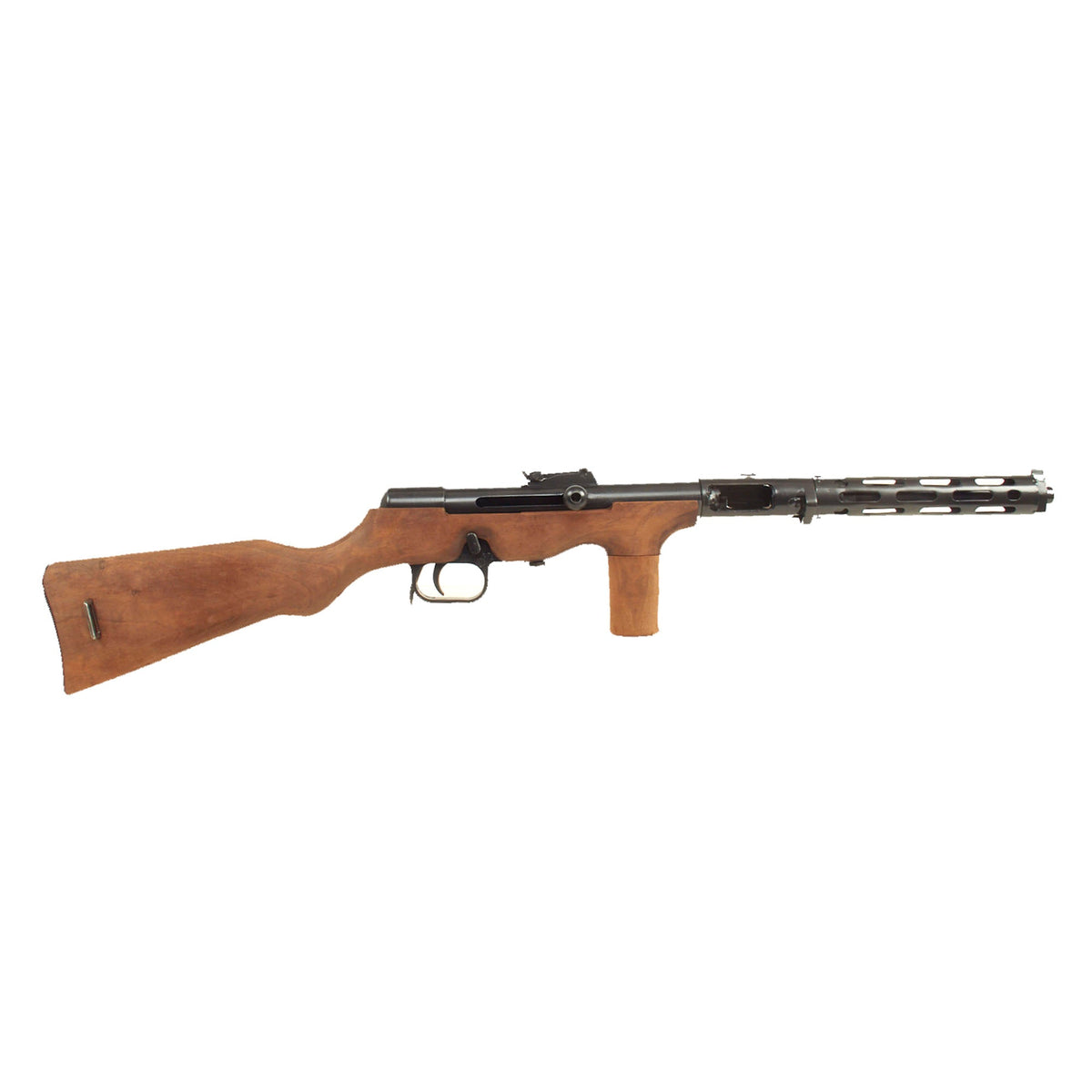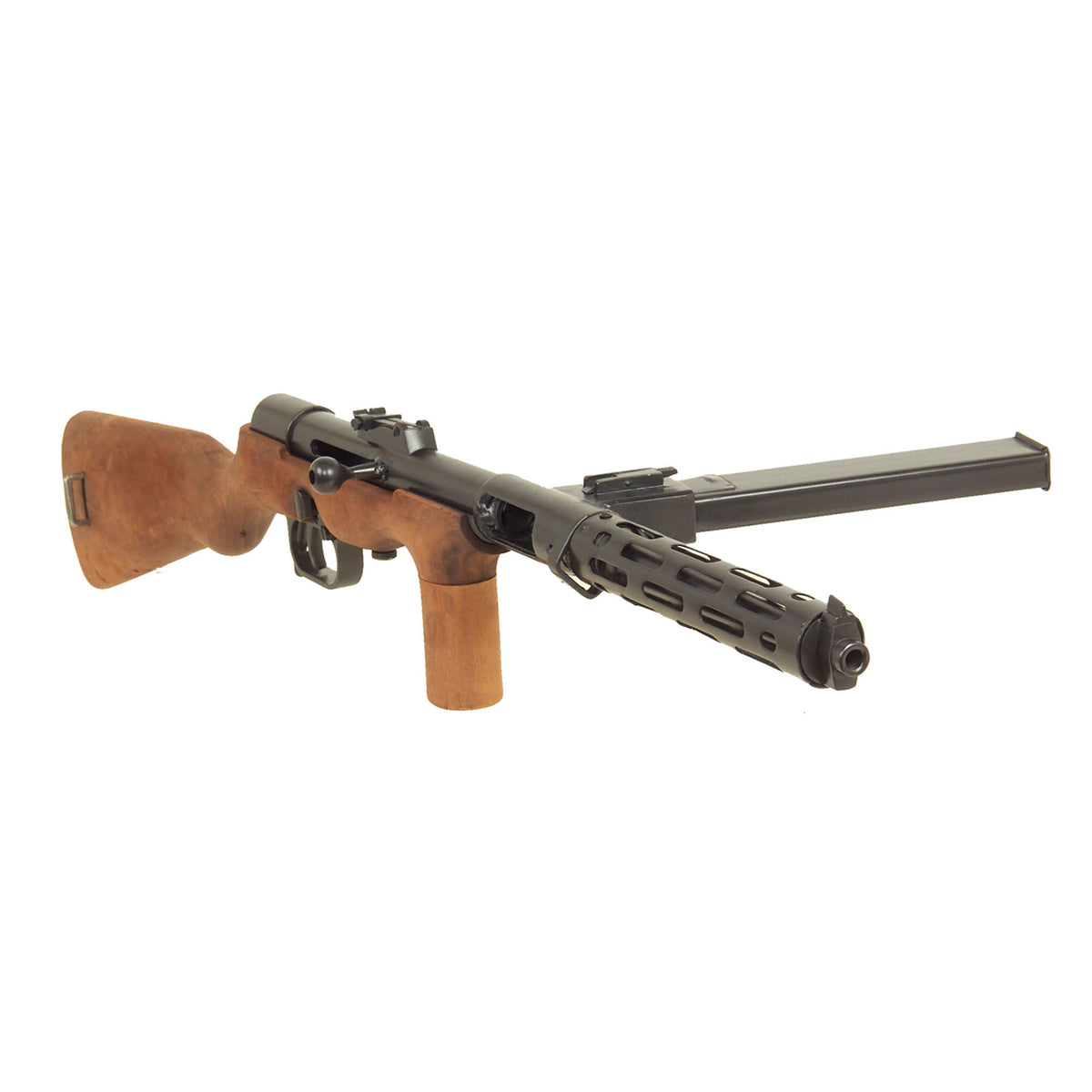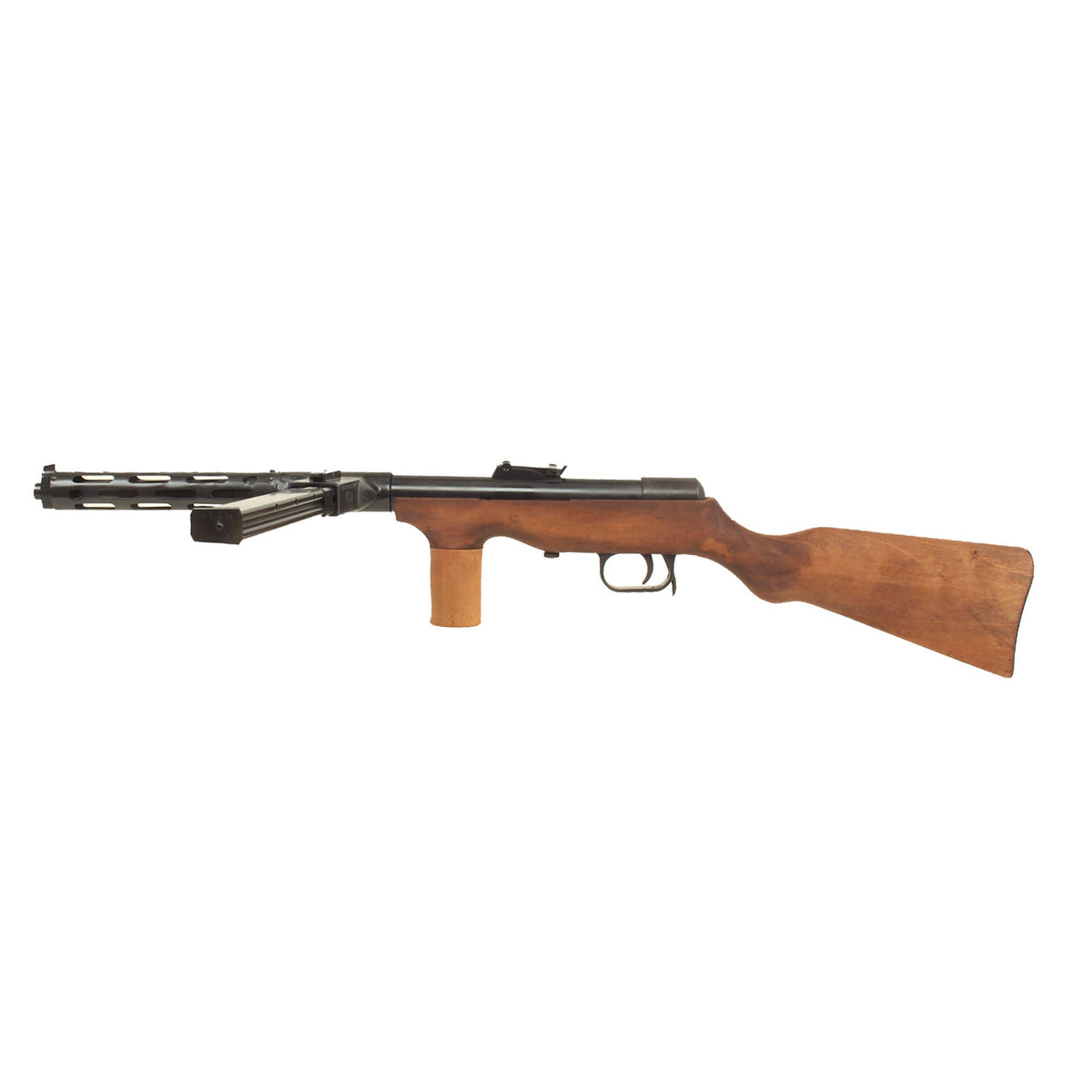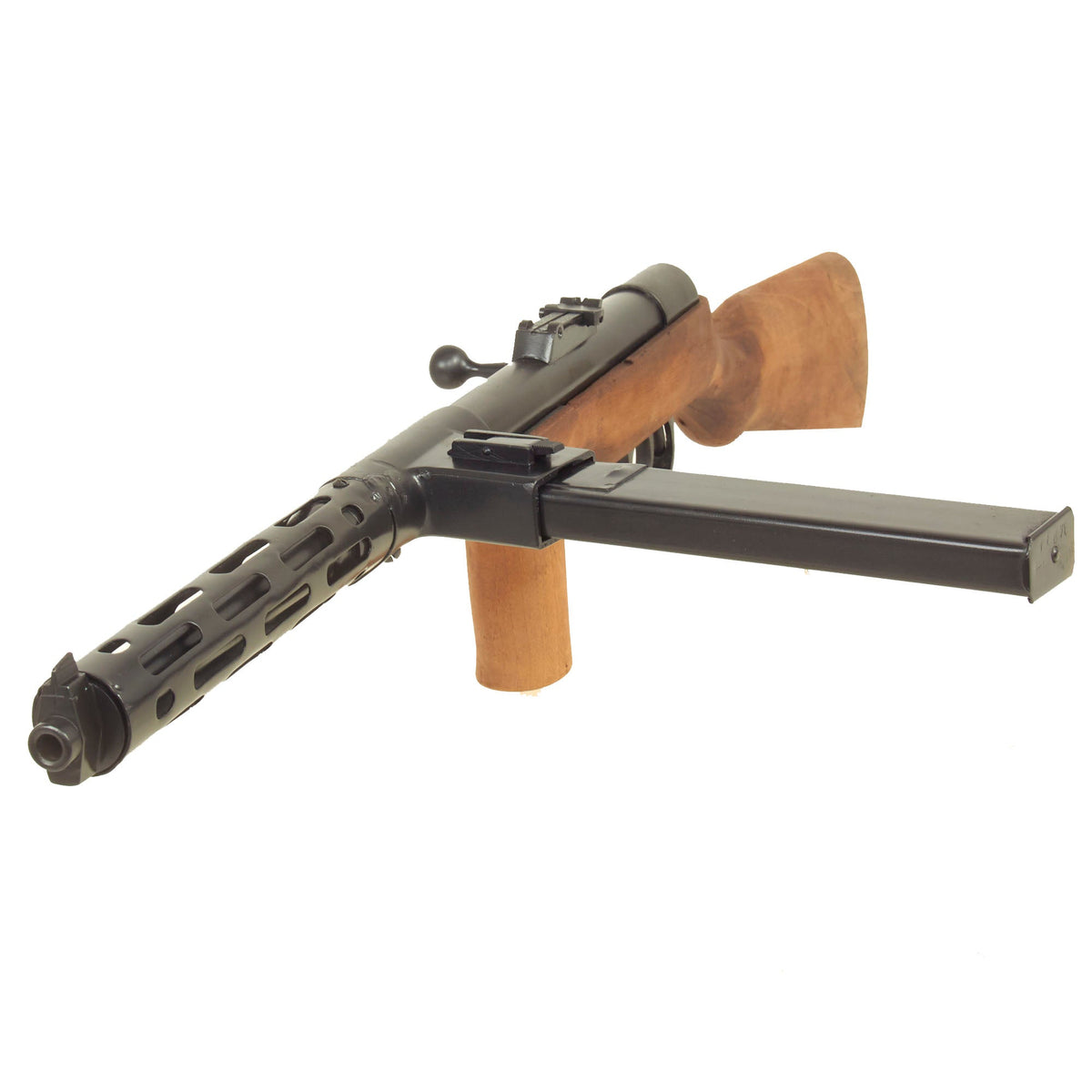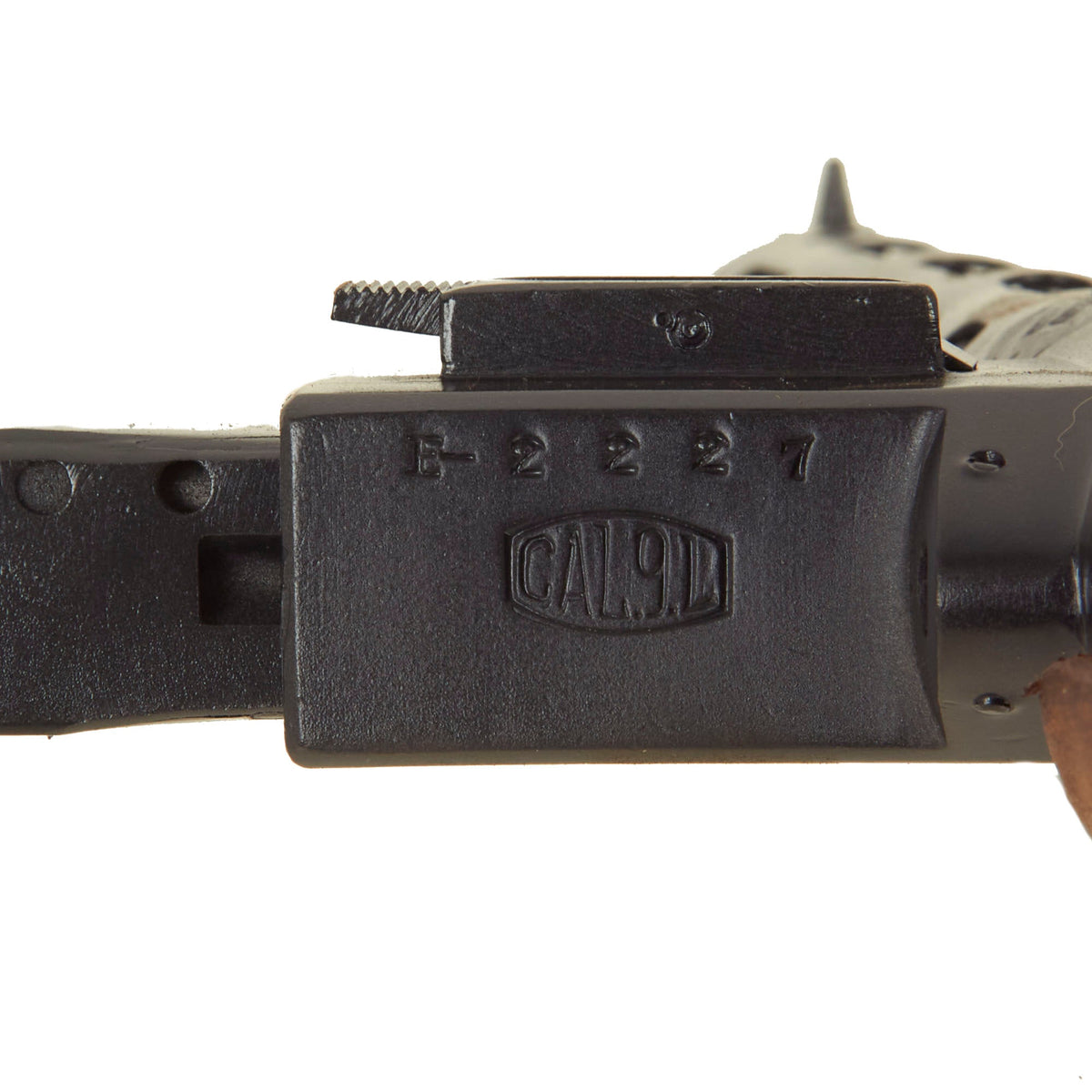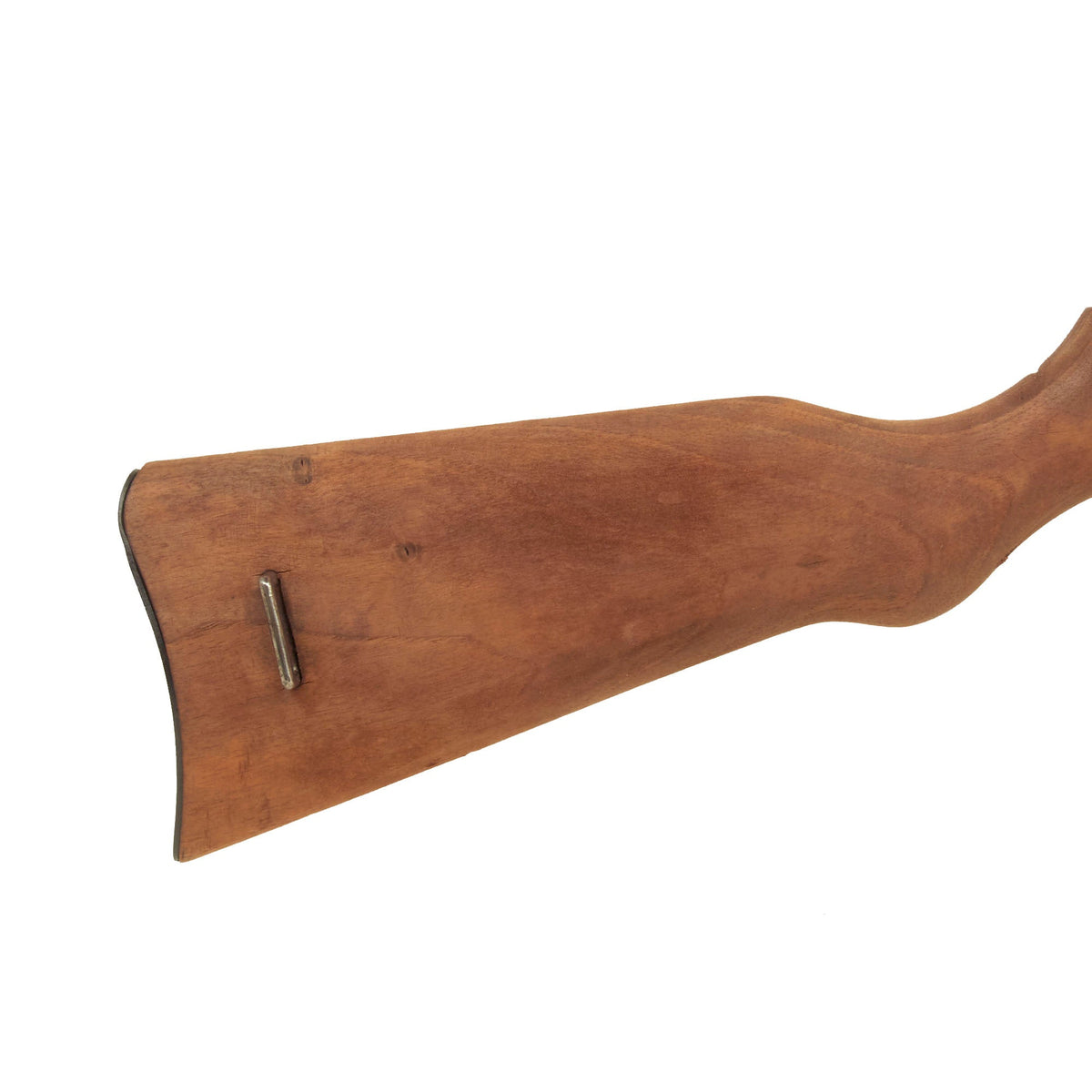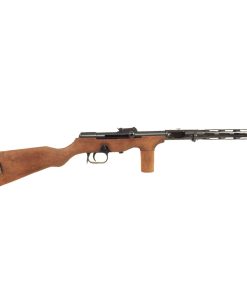Original German Pre-WWII ERMA EMP Display Sub Machine Gun with Display Magazine – Serial E-2227 Original Items
$ 895,00 $ 223,75
Original Item: Only One Available. Just purchased from a private collection, this is a fantastic ERMA EMP Inert Display Sub Machine Gun, built from all original parts on an original BATF compliant non-firing display receiver, making this a 100% legal display Sub-Machine gun. This receiver was created by using portions of the original torch cut receiver, including the barrel bushing, combined with some new made steel portions. It has properly had a 25% section of the total length completely replaced entirely with solid steel bar stock. Meaning a 1/4 length section of the display receiver is solid steel, making this totally legal to own without a license of any kind. Every part on this display gun is original Pre-WWII manufacture other than 25% of the receiver replaced by solid steel (as required by BATF). The ends of the barrel have also been welded up to deactivate it.
This is a very nice example of the ERMA EMP (Erma Maschinenenpistole) designed and manufactured by Erfurter Maschinenfabrik (Erfurt Machine Factory or ERMA), usually simply called ERMA Werke. The magazine well is marked with serial number E – 2227, over a CAL.9.L. marking, indicating chambering in 9mm Largo, the standard round used for guns supplied to Spain. The included magazine is a modified 9mm Sten magazine, which is press fit into the magazine well. It takes a lot of wiggling to remove it at present.
Condition is very good, with a moving trigger and release for the receiver, though the receiver can no longer be unlocked with it. The selector switch on the right side is still present, though it cannot move much due to how the display gun was constructed. The stock is in very good shape, and looks to be an arsenal spare, so it shows very little wear at all. The included modified sten magazine will be deactivated where required.
Overall a very nice example of a hard to find Pre World War Two SMG, ready to research and display!
The German sub-machine gun EMP (Erma Maschinenpistole) also known as MPE (Maschinenpistole Erma) was produced by the Erma factory, and was based on designs acquired from Heinrich Vollmer. The gun was produced from 1931 to 1938 in roughly 10,000 exemplars (in three main variants) and exported to Spain, Mexico, China and Yugoslavia, but also used domestically by the SS. It was produced under license in Spain by the arsenal of A Coruña under the designation M41/44.
In the early 1920s, Vollmer started to develop his own sub-machineguns. His early models, named VPG, VPGa, VPF and VMP1925 were fairly similar to the MP18. The VMP1925 had a wooden handgrip and was fed by a small 25-round drum magazine, connected directly to the gun. The VMP1925 was secretly tested by the Reichswehr, along with competing designs from Schmeisser and Rheinmetall. (The Reichswehr was prohibited by the Versailles Treaty from having sub-machine guns in service, although the German police was allowed to carry a small number.) Secret funding was given to Vollmer to continue development, and this resulted in the VMP1926, which mostly differed from its predecessor by the removal of the cooling jacket. A subsequent development was the VMP1928, which introduced a 32-round box magazine sticking from the left side. The final development of this series was the VMP1930. (It can also be seen at the WTS.) This model introduced a substantive innovation: a telescoping main spring assembly, which made the gun more reliable and easier to assemble and disassemble in the field. Vollemer applied for a patent for his innovation in 1930 and it was granted in 1933 as DRP# 580620. His company, Vollmer Werke, produced however only about 400 of these, and most were sold to Bulgaria. In late 1930, the Reichswehr stopped supporting Vollmer financially; consequently he sold the rights to all his designs to the company known as Erma Werke (which is an abbreviation for Erfurter Maschinenfabrik, Berthold Geipel GmbH).
The submachine guns that Erma started to sell in 1932 under the names EMP (Erma Maschinenpistole) or MPE (Maschinenpistole Erma) was basically just the VMP1930 with the cooling jacket restored. Although there were several variants with varying barrel lengths and sights made to customers’ specifications, roughly three main variants were produced: one with a 30 cm barrel, tangent rear sight and bayonet lug was apparently sold to Bulgaria or Yugoslavia. The second model, sometimes called the MP34, or the “standard model”, had a 25 cm barrel and no provision for a bayonet; the rear sight on these varies – some had a tangent sight, others a simplified flip-up “L” sight. A third variant was basically similar in the metallic parts, but replaced the foregrip with a MP18-style stock with finger-grooves. Overall, at least 10,000 of these Vollmer-based designs were made by Erma. They were adopted by the SS in 1936, but also sold to South-American countries and to Spain, where it was subsequently manufactured locally under the designation M41/44.
In the Spring of 1939, a large number of defeated Spanish Republicans fled to France, where they were disarmed. Some 3,250 EMPs formerly in the possession of these fighters ended up in a French warehouse at Clermont-Ferrand. The EMPs were usually referred to as the “Erma-Vollmer” in French documents. The French tested the weapons and decided to adopt them for their own service. A provisional manual was printed in French as Provisoire sur le pistolet-mitrailleur Erma – Vollmer de 9mm, issued on December 26, 1939 and updated in January 6, 1940. However, the French had obtained only some 1,540 suitable magazines for these guns, so only 700-800 EMPs were actually distributed to the French forces, mostly to the Mobile Gendarmerie. After the NSDAP conquered France, some EMPs armed the Legion of French Volunteers Against Bolshevism, which eventually became part of the SS Charlemagne division. This division was practically destroyed in February 1945 in Eastern Prussia, now part of Poland.
Numerous EMPs have been found in the last-stand battlefields of the SS Charlemagne division; most of these guns lack any German military stamps or marks. The EMPs which arrived in German hands via the French route were given the (Fremdgerät) designation 740(f).
In Francoist Spain, the EMP was produced chambered in the 9mm Largo cartridge. It was informally known as “subfusil [modelo] Coruña”.
Caliber 9 mm
Action Blowback
Rate of fire 550 rpm
Muzzle velocity 380 m/s (1,200 ft/s)
Effective firing range 150 m (490 ft)
Maximum firing range 250 m (820 ft)
Feed system 32-round magazine
Sights Iron
Fast Shipping with Professional Packaging
Thanks to our longstanding association with UPS FedEx DHL, and other major international carriers, we are able to provide a range of shipping options. Our warehouse staff is expertly trained and will wrap your products according to our exact and precise specifications. Prior to shipping, your goods will be thoroughly examined and securely secured. We ship to thousands clients each day across multiple countries. This shows how we're dedicated to be the largest retailer on the internet. Warehouses and distribution centres can be located throughout Europe as well as the USA.
Note: Orders with more than one item will be assigned a processing date depending on the item.
Before shipping before shipping, we'll conduct a thorough inspection of the items you have ordered. Today, the majority of orders will be delivered within 48 hours. The delivery time will be between 3-7 days.
Returns
The stock is dynamic and we cannot completely manage it because multiple stakeholders are involved, including our factory and warehouse. So the actual stock may alter at any time. It's possible that you may not receive your order once the order has been made.
Our policy is valid for a period of 30 days. If you don't receive the product within 30 days, we are not able to issue a refund or an exchange.
You can only return an item if it is unused and in the same state as the day you received it. You must have the item in its original packaging.
Related products
Uncategorized
Uncategorized
Uncategorized
Uncategorized
Uncategorized
Uncategorized
Uncategorized
Uncategorized
Uncategorized
Australian WWII Owen MK1 Machine Carbine SMG Custom Fabricated Replica with Sling Original Items
Uncategorized
Uncategorized
Uncategorized
Uncategorized
Uncategorized
Uncategorized
Uncategorized
Angolan Rebel 1970s era 60mm Inert Display Mortar from Angolan Civil War Original Items
Uncategorized
